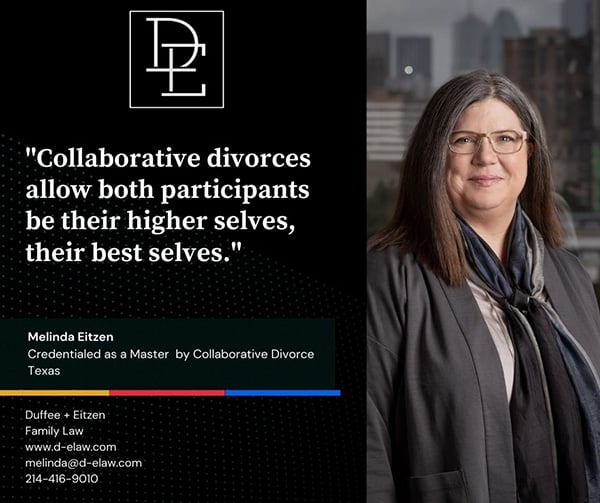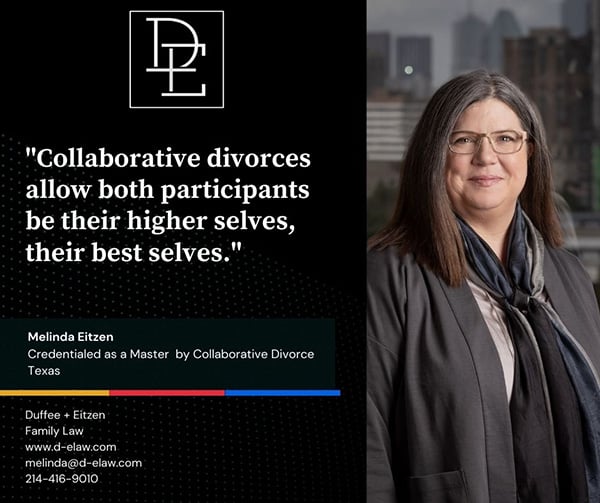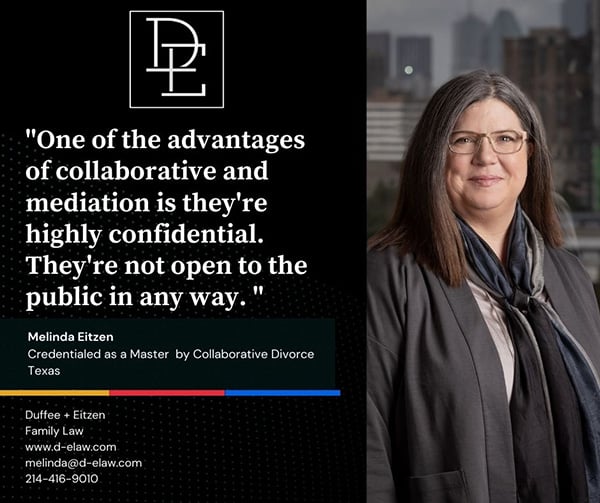5 Things You Should Know About Collaborative Divorce

- Written by Duffee + Eitzen
- Categorised Collaborative divorce
Melinda Eitzen is in her 27th year of litigating.
Having also practiced collaborative law for 20 years, she is well positioned to handle any turn a divorce might take. She also teaches and trains other professionals, lawyers, mental health professionals, and financial professionals how to do collaborative work in TX and around the country.
Why is collaborative divorce good?
Collaborative divorces allow both participants be their higher selves, their best selves.
Collaborative law focuses on creative solutions to resolve the case.
As long as both parties can agree on a creative solution, anything is possible.
Where collaborative divorce, by definition, means that both parties work together toward a positive outcome, litigation is more mudslinging in nature. And it is more backward looking. Working together allows both parties to focus on what is important. In collaborative divorces, there is always a team in place to facilitate forward movement. The team includes the two collaborative attorneys and two neutrals: one mental health professional and one financial professional.
In collaborative, the decision makers are the litigants - the husband and the wife. In litigation, if you can’t make a decision the judge will make it for you. One of the benefits of collaborative is you’re never expected to make a decision, right then, at any given point. You can take time if you feel like you need it—or think about it and come back and make the decision when you are ready.

What makes a particular client a good fit for the collaborative process?
If both parties desire an amicable divorce and are willing work things through, collaborative divorce is a good option. If you feel strongly about the intimate details of your married life remaining private, collaborative divorce might be what you are looking for. Collaborative divorces are handled outside of the courtroom- which means that your private details are not on court record (that can be viewed by anybody). If your family has special circumstances that require non-traditional creative solutions that you would both agree to, collaborative divorce allows for that.
The mental health professional is neutral- not on either party’s side. They’re not there to do therapy- they help both parties to deal with the anger, sadness, fear that gets in the way of the deal. They’re there to help facilitate the case. They’re the leader of the team, the leader of the meeting. The mental health provider take us through the agenda.
The other neutral is the financial professional, who is the leader of conversations about money including division of assets and debts, how children’s expenses will be paid going forward and spousal support, if any.
Normally, the neutral financial would give a list to both of the clients of the information they need. And then the clients provide that information to the neutral. Some of the neutrals have an electronic vault for the information . The lawyers can access the vault and so can the clients at any time to see the data. This saves the clients money.
One interesting thing of note about the collaborative process is that it is, by statute, a transparent process- which means that any information anyone wants, they get. In litigation, that’s not true. In litigation, we ask for information, and then we can have a big fight about if it’s relevant, is it too much information, it’s too burdensome to get it and so on. And then the judge will decide how much information we get. In collaborative there’s none of that. Instead, you ask for it, you get it, period. You’re much more likely to get the information you want and need in collaborative than in litigation. *
The collaborative process is very confidential
You cannot put any of the neutrals we talked about on the witness stand in Court in the future. Nobody can testify about what was said. You can’t take a document that existed outside of collaborative like your tax return, and lay it on the table in collaborative and create confidentiality around that, . But if the information was created in the collaborative process, like the spreadsheet that the financial professional creates, it’s confidential.
Now, having said that, you could both agree, the parties could say, we like that spreadsheet, I want to use that in litigation. If they both agree, they can certainly waive confidentiality as to that piece of information if they want to, and benefit from that information. But I’ve never met a neutral who would be willing to testify even if the parties waived it. They’re not going to testify, but they their work product maybe could survive if everyone agreed.

Litigation is more revenge focused.
In collaborative cases, when you start helping clients to see the bigger picture, and help them to see, if you don’t really need that item you’re hanging onto for revenge, maybe we can trade it for something you really do need and want. In this way, collaborative is very interest-based. An Interest is different than a position, because it redirects the parties to the WHY’s behind what is important to them- and the whys are usually quite valid. Collaborative attorneys are less about looking backwards because they want to find ways to place you in the best position going forward.
What happens if collaborative divorce doesn’t work?
Either or both spouses can terminate a collaborative divorce at any time. If this happens, the collaborative attorneys will resign, and both parties will need to find new legal representation at another firm. They will have to pay the new attorney to learn everything from scratch. Having said that, the success rate tends to be high for these cases.


Contact Us